THe Truth Is Rarely Pure And Never Simple -Oscar Wilde
For the past few years, the great debate in the stuffy world of wine has been alcohol. It is a topic that people feel passionately about. It is also one of those rare topics in the discussion of wine that has actual concrete parameters that can be discussed. Thus it is a great thing to base symposiums and discussion groups around.
I for one could care less what the alcohol percentage is of a wine. Either I enjoy it or I don't. But the number is printed on the label and gives ammunition for all with a bone to pick. The most common bone being picked is that high alcohol wines are a stylistic decision made by lazy winemakers. People who dislike high alcohol wines claim it as evidence as an attempt to make big flabby overripe wines to trick some critic into giving out a big numerical score to the wine.
Like I have discussed earlier in this blog, I pick mainly by using my natural senses. I like to look at the chemistry just so I know what I'm getting myself into as far as the ferment goes. But the decision as to is the fruit ready to come off the vine, I trust mainly my sense of taste, touch, and sight while walking the vineyard. (If I am smelling or hearing the grapes on the vine, that is an indication that I should have picked yesterday.)
One of the big reasons I have decided to swing my decision making so far into one camp is due to the fact I make wine in Paso Robles. This is a unique place making unique wines. If there is a textbook out there that explains making wine in Paso, I haven't read it yet. Most accepted thought on winemaking was established elsewhere, thus I always take lessons from afar with a grain of salt. For a case in point, let's look at the 2011 harvest.
Things are all over the map this year. Early ripeners are developing late and vice versa. I picked some Tempranillo last week that was 23.8 Brix and 3.95 pH. Sure that's just the low acid nature of Tempranillo, but even though it will end up being around just 13% alcohol, the fruit was plenty ripe and I didn't want to let it hang another day. Then this weekend we picked some classic Paso Robles fruit.
Our Kate's Vineyard Zinfandel is always one of my favorite picks of the year. The vines are not overly vigorous for Zin, and produce amazingly complex wines. One of the main reasons for the complexity is high acid and tannin in the must even when pushed for ripeness. Here is the brix measurement after a 4 day cold soak.
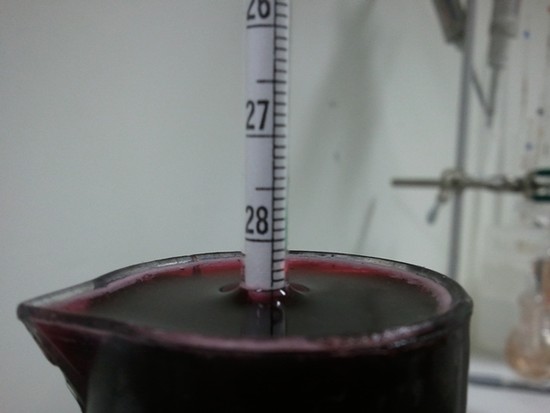
28.5! There I go chasing big scores with my big lazy overripe jammy Zin that is going to taste like some Virgin Islands cocktail. If I was making proper wine, I would be pushing for balance, restraint, nuance, complexity. I would have picked it 3 weeks ago at a respectable 25 brix. Instead I'm just going for power to win over some critic who is never going to taste this wine anyway.
Well before we start jumping to conclusions; let's look at some more evidence. I can't have you virtually taste this, so I can't prove that this wine is going to be incredible. But check out this photo:
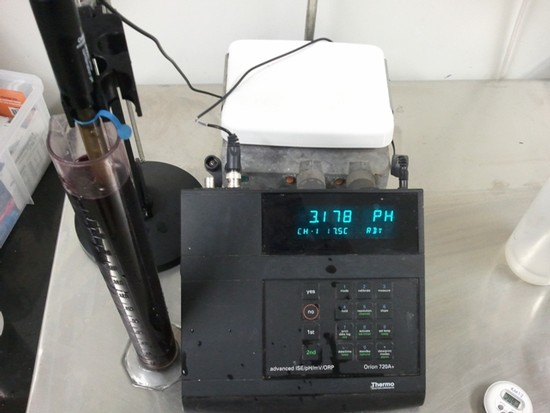
Wait, what? 3.178 pH. My favorite was the sample I took 2 weeks ago that was 26.2 Brix with a 2.84 pH. So there I go, trying to impress the euro snobs with my austere acidic wines that will take years of ageing to be drinkable.
So who am I making this wine for? Well, I'm making it for the people who have tasted our Zin and love it. Sure these numbers are off kilter, but this must tastes right it its own peculiar way. Big and ripe but with amazing backbone, color and tannin to bring everything into proper balance. Our 2007 Zin had very similar chemistry and it sold out in about 3 weeks. If I could get the numbers to be more traditional, but had to sacrifice what this must tastes like, I would never go for that.
Next time someone wants to look at the % number on the wine label and pontificate about the winemaker's intention, tell them this little story. This world is not always so black and white.
I firmly believe there is single most important job for a winemaker, deciding when to pick the fruit. The best a wine will ever be is the moment you pick it. All you can hope to accomplish is to lessen how much it degrades. The techniques you read about in the produciton notes of your favorite wine cannot improve the wine, they represent only our best efforts to fully capture and express what is within the fruit. Since determening the pick is such an important task, I'm surprised how little attention it gets.

The how and why of picking dates is different for each winemaker. The separate routes taken to this end represent most of what is the underlying character of the wines produced by different winemakers. The routes are plentiful due to the mass of information available and the varied interpretations of that information.
You can break up most of the information into two rough categories, vineyard observation and lab data. The safe thing for the modern winemaker to say is that both forms of information are equals. But from what I see, most people lean towards one or the other. On one end you have the winemaker who reads only spreadsheet charts and can track the exact optimal moment of balanced sugar, acid, polysaccharides, phenolics, anthocyanins, etc. If you have 5,000 acres of fruit you are responsible for, it is pretty impossible to go "walk the vineyard" and decide how it's tasting. On the other extreme you have the winemaker who eats the fruit in the vineyard and looks at the vine for changes in shoots, leaves and stems. This really works best when you have a single vine in your backyard. So where you ask do I find myself in this continuum?
Being an organic chemist by training and trade, one would expect me to be most smitten with the data avalanche of the well-stocked winery lab. At first, that made most sense to me. But the more harvests I undertake, the more and more the vineyard and tasting the fruit have started to dominate my decision-making. The main reason I have made this change is a newfound belief that this decision is what we humans are designed to do.
When I was working in biotech as a multi-step organic bench chemist, most of the PhD's working there were Soviet trained. With this Soviet training came some "old school" techniques. The PhD I worked most closely with often made decisions about the success or failure of a reaction base on smell. The sane thing to do is to run a sample in the GCMS. But this takes about 20 minutes start to finish in a busy lab, and smelling the reaction is instant to the trained chemist nose. In fact, the history of organic chemistry pre-dates the analytical tools of the lab because early chemists could look at, listen to, feel, smell and taste their reactions. These senses of ours amazingly powerful, they easily rival large instruments costing hundreds of thousands of dollars. And they are never more powerful then when being used for their actual purpose.
The tasting of ripening fruit is an example of one of those actual purposes. Think about your sense of taste for second. Why should you want to taste things, what's the point? Well, first and foremost it immediately tells you if something is good or bad to eat or drink. If you could not taste salt, how could you tell if water was fresh and drinkable, or like the vast majority of water available to you, salty and dangerous. Without sour, bitter, sweet and Umami (wait, what? I think I missed a memo.) how could you tell if fruit is going to be a nutritious snack or a belly ache waiting to happen? This to me is the whole point of our ability to taste, so we know when fruit is good to eat. Lucky me, to have such an amazing tool to help me with my job.
The whole process is incredible to me. The vine wants to spread its seeds around. It decides to surround its seeds in a tasty treat so that animals will eat them and the seed will travel with them. The danger for the plant is the animal wanting to eat the fruit before the seed is ready. So while the seed matures, the fruit needs to taste unpleasant to the animal. Thus the young grape is extremely sour and bitter with very little sweetness. Once the seed is ready though, the fruit quickly loses bitterness and acidic flavors and becomes more and more sweet. At a certain point there is a perfect balance that may not be the exact best moment to eat the grapes, but is the exact best moment to make perfectly balanced wine.
Standing in the vineyard, eating grapes in the morning, the tuned winemaker sense machine can accurately determine brix and pH along with skin tannin and color and many other chemicals. It is a fun test to make a best guess as to the pH and Brix when tasting fresh must. The winemakers I learned from would have no problem producing a number that was within 1 Brix of a hydrometer and 0.2 pH of a probe.
There are even some things that only tasting the fruit can give you. Like tasting the difference between crisp and mushy watermelon, the consistency of the pulp is one of those vital things that I have never seen determined in a lab. (Note to self, build a little spring tension device that produces a "firmness" number, sell to wine labs, retire.) Things like cane and stem lignifications and leaf color change can only be determined by actually visiting the vine. I cannot see how it is possible to be absolutely confident you are picking the fruit at an optimal moment without spending time in the vineyard using your senses. Because really, that is what they are there for.
One of the side jobs that comes with becoming a winemaker is the position of chief of all family wine questions and situations. As someone who just plain loves wine, I’m not always the best suited for this job. When a family member does a bit of research and tells me, “Oh, let’s hold off on the Chardonnay right now because I heard that you can’t drink it with the salad dressing I used.” I can tell that they really don’t care, that they are just worried that I will look at them scornfully as they serve me the evil mixture of wine and vinegar. As if people expect me to fly off the handle yelling, "How dare you ruin the sanctity of my wine that I perfectly crafted. This meal is RUINED!" Instead, I usually reply with something like, “You know, that might be technically true, but who cares. Never hold off on drinking wine, bad pairings can be just as fun as a good one. You can see what difference the food makes in the way the wine tastes." This is a great way to truly understand food pairing.
Wine's relationship to our palates fascinates me endlessly, so I’m not one to dogmatically follow the rules of food and wine. Like most trained scientists, I feel there is just as much to learn in failure as there is in success. Sadly, my offhand dismissal of hard and fast rules just makes everything more confusing for my family.
These situations always get me thinking about why wine can be so confounding to those first exploring it. I think people are scared that they will demonstrate some form of wine ignorance by flubbing a basic rule. Well, rules like these are meant to be broken indeed. The world of food and wine is so complex, simple rules should only be the roughest of guidelines. As an example wines are often described as being "food friendly". I guess this is said implying that some other un-named wine is unfriendly or just plain rude. Since wine is so completely intertwined into the culinary experience, this has to be one of the harshest critiques possible of a wine. The problem that immediately comes to my mind is this: What does the critic in this case mean by "food"?
When I lived in San Francisco, a typical 8pm question was, “What should we eat tonight?” I know this is a common problem in homes throughout the world, but the seemingly endless choices made available in my neighborhood invoked that same feeling of hopeless confusion as when choosing a toothpaste.

Anyway, here is just a sample of the choice of restraunt styles that were within a 4-minute bike ride of my front door:
American, New American, Southern, BBQ, Californian, Cajun, Seafood, French, Italian, Vietnemese, French-Vietnemese, German, East German, Hipster German, Pizza, Southern Indian, Northen Indian, Pakistani, Chinese, Nepalese, Cambodian, Thai, Ethiopian, Senegalese, Moroccan, Spanish/Tapas, Peruvian, Nicaraguan, Mexican, New Mexican, Tacos, Burritos, Vegan/Raw, Cuban, Japanese, Mediterranean....(Man, now I need to spend a week eating in the Mission)
The idea that there is some formula out there that x and y features of wine make it good with "food" seems totaly absurd. I don't care what the pH, TA, tannin, alcohol, balance, ten-cent wine descriptor, you can find a food that works for you with pretty much any wine. I've met people who swear by sushi and whiskey! Not my ideal pairing, but if you love it, anyone who tells you otherwise can take a walk. When one combines the entire spectrum of sustenance with all the styles and characteristics of wine, then throws in the full range of human taste and experience, I think you’d have to be a Numberwang champion to figure out all the possibilities.
So take this as a challenge to disregard much of what you’ve read or heard and just go exploring. Eat at places that are passionate about what they serve and express a unique point of view. That passion will lead them, and in turn you, to all sorts of interesting and unexpected places that simply following “the rules” would steer you away from. The role of the experts should not be to confuse you and limit your choices, but instead be a role of expanding and leading you to try something you might otherwise avoid. Any sommelier will tell you the greatest triumph in pairing is the success of the unexpected. Don’t be afraid of failure or of some snobby upturned nose at a bad pairing. Try anything and everything with the full confidence that failure and success are both wonderful outcomes when it comes to wine and food. This more than any book, video, magazine, or blog will lead you down the path of understanding your unique palate.

The vineyards this morning produced a most philosophical perspective in me. Sunrise amongst the greenery and expansive views sometimes bring forth thoughts beyond worries of heat stress and micro-nutrient uptake. My thoughts were constantly returning to what is this essence of wine that fascinates? Why don’t people spend weekends traveling the back roads of Forest Grove Oregon and why are fortunes not made and lost based on scores from the Rutabaga Advocate? Is the wine grape a most noble crop that resides in a special world of agriculture above all others? Not that I have seen or experienced. A product lovingly raised is always unique and cherished. How then do we explain the belief that wine is portal through which deeper knowledge comes? Countless Movies, books, and blogs have all been dedicated to idea that wine produces a unique signature of place, the terroir. But does a grape vine speak more to the terroir than an heirloom tomato or pasture raised beef? In this summer season of plenty, with the mantras of slow food and flavors of locality preached on each menu, you would be mad to suggest so. Any random combination of those offerings explains Paso Robles on the palate just as much as a wine can. So again I ask myself, why the captivation with this drink?
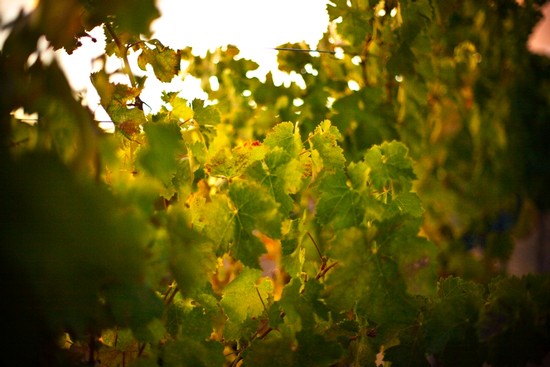
The answer to these type of questions often lie in that time which formed my perspective, my youth. Maybe it’s the answer to the riddle the Jims (Henson and Croce) asked of me in childhood. I remember the strange anxiety that small skit created in me and my initial dawning of thought on the enigmatic complexity of life, time and space. This great mystery of the unflinching progression of things was always with me in quiet times. In order to remain calm, I convinced myself that there must be a path of grace (with apologies to Terrence Malick) that could lead one away from fear and into understanding. Just because something is beyond comprehension does not mean one should recoil from it; the unknowable should be embraced. The wine we produce then is a product of that acceptance. The vintage is, in its essence, the capturing of the moment into some tangible state.
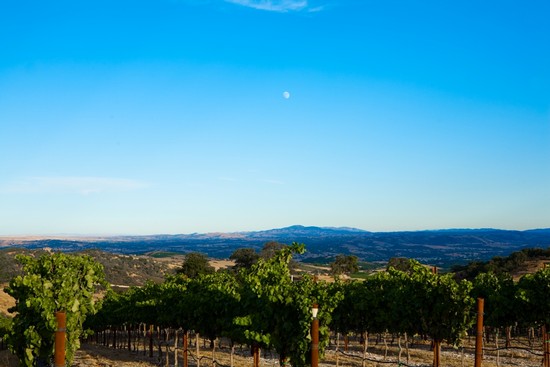
There is something more to wine than mere ethanolic intoxication. The corked bottle represents a chance to return to a place and time, without trepidation that the past is lost forever. Wine with its intrinsic link between our senses and memory can provide a wonderful window unto personal contemplation and revelation.
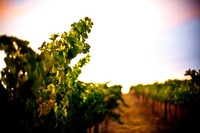
The idea of wine and the memory of my favorite wine experience are forever linked. This occurred on the island of Samos in the Aegean Sea. My future wife and I were enjoying a beach-front campground with a single little market from which to order our dinner. We sat eating a meal of fresh grilled octopus that neither of us would have ordered in different setting. Drinking a local wine, Samos Vin Doux (a fortified muscat!), that we picked off the shelf because it was the only bottle offered. Yet this perfect combination of all things new and beautiful along with the sun resting into the sea, created for us an experience that nothing could ever top. While not by any means the most technically superior wine I have ever had, it is perhaps the best wine I will ever drink.
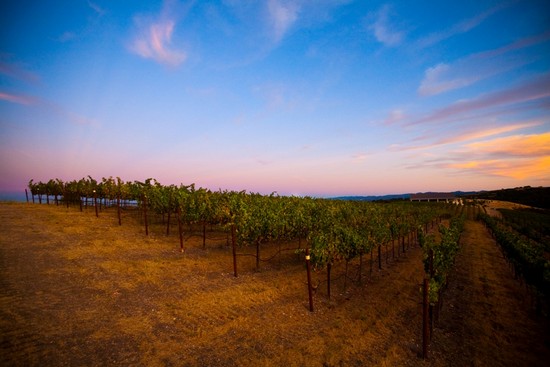
So maybe this isn’t madness, laboring as we do to create wine. As the spectre of harvest looms just weeks away and I prepare to be enveloped completely by its demands, these thoughts give me assurance that it is all worth it. That the sacrifices that must be made of time, energy, mind and family will be rewarded. The goal is sitting out there plain to see in my mind. For me it is the end of November, with fermentations few and a Thanksgiving table filled with family, friends, food, and of course, wine.
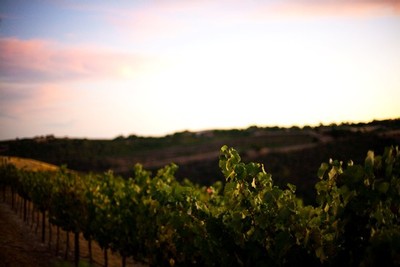
One of the challenges of working with a newly producing vineyard is that is takes you quite a few vintages to figure out your barrel program. Winemakers will all have favorite barrels that are kind of their go to options, but until you get to really know the fruit the vineyard is producing, it's mainly guess work. Different barrels will add different features to the overall experience of the wine. Suffice to say, some barrels you smell and taste in the wine. Other barrels you only feel. And only developing that first hand knowledge of what the fruit from a vineyard needs will allow you to have a successful barrel program.
To begin this post in another way, experimentation with barrels is still the name of the game here at Calcareous. A barrel that I brought in for the first time in 2010 was Keystone Cooperage. I had asked around few other winemakers in Paso and gotten positive feedback about Keystone. Solid barrel for Cabs, Syrahs, and Zins was the general consensus. That can be a bit scary though because those are the big boy wines and are capable of hiding barrel character. I often talk about how early American coopers made oak barrels for things like salt pork and whiskey. Nobody cares if there's a bit of woody flavor in those things. I mean, throw down a shot of Old Potrero and impress the crowd by saying "Oh that's really smooth but the oak finish really overpowers there." Um, probably not going to happen. You need all the smoke and wood possible to stand up to the huge flavors in whiskey, so the barrels can be monsters. Thus American barrels had a bad reputation because Chardonnay can, at times, be a bit more restrained then rye. Luckily things have changed.
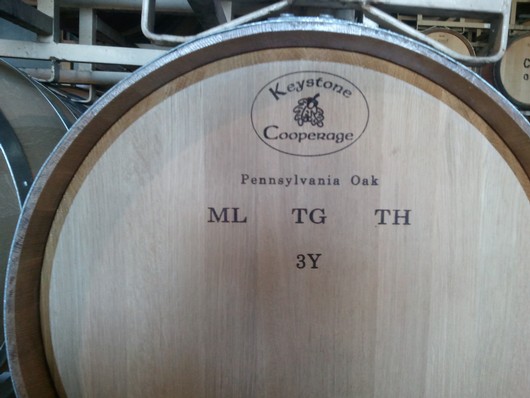
To prove the point, let's decipher all the letters and numbers on that barrel head. First the cooperage stamp is rather self explanatory. Nice little oak leaf and acorn design there I must say. Next, most American barrels will now tell you where trees were grown. The climate that the forrest grows in determines the grain structure of the wood. Warm regions produce faster growth and wider grain. Cold forests have shorter growing seasons thus tighter grain. And when it come to American White Oak, there is a big range of where it grows.

From East Texas to Maine the great Quercus alba forest covers nearly a third of the country. Keystone is Pennsylvania only, thus you generally get medium to tight grain wood in their barrels. That is what the "TG" stands for, "tight grain". Not to produce a full tome on oak here, but generally the tighter the grain, the slower the extraction from the barrel will be.
The letters "ML" indicate the toasting level. In this case "ML" means "medium long". I requested this toasting style which is a lower heat for a longer time. A medium toast will give you more oak structure instead of the smoke and caramel you get from the toasting process. Again, that is a decision you need to make based on what you feel the wine from your vineyard needs. Also, when working with a barrel for the first time, I like to try and taste the wood not the toast. The toast can be fined tuned, the wood is the wood. The longer time of the toast gives you a deeper penetration into the wood. Thus if the wine is in the barrel for 18 months, the toast is deep enough to prevent the wine from interacting with un-toasted wood. The "TH" is another toasting indicator, meaning "toasted heads" The heads account for a significant amount of the surface area of the barrel, thus toasting the head as well is an important step if you want to control the impact of the barrel.
Lastly is "3Y" which means "three years" of wood aging. Once the trees get turned into stave logs at the mill, they sit outside. Two years is the basic time your average cooperage will allow the wood to age outside. The longer the wood is exposed to the sun, wind and rain, the milder the "oakiness" becomes. This is one of those "aha" things the French had to explain about how to make barrels for wine instead of whaling ship rum. Thus, with American oak that can be a bit more powerful than French oak, I prefer a full 3 years of weathering. It costs a bit more, because the stave mill needs to have the oak sitting around for an extra year before selling it, but for me it is worth it.
The last thing about these barrels that you can't see here is that they are a slightly larger size. I order these barrels in the 265 liter size. The normal French barrel size is between 225/228 liters depending on the shape. By having a larger barrel, you decrease the surface area to volume ratio, thus producing a situation with less extraction.
This month, finishing my initial tasting trials for these barrels, I have been pleased. I think Keystone will be with us for a while. If you stop by the winery, look me up and you can taste for yourself.
One of the things that connects me most to winemaking at a small family owned winery like Calcareous is the handmade nature of the product. All work done on the vines is done by hand. The fruit is hand picked. And in the winery during crush, the wine making here is defintely hands on. Which all comes to mind this time of year when meeting with the salespeople and coopers from the cooperages that make the barrels we use. Although for simplicity reasons we often categorize the oak used in wine making as French, American or European, reality is much more interesting than that. After all, do we just lump in all grapes as being either French, Spanish or Italian?
Making barrels is just as much an ancient artisian craft as wine making. Each barrel is hand made and toasted by some one with oak staves, steel hoops, a hammer, and a fire pit in the ground. The way the flavors of the barrel integrate with the wine and the life the wine lives while aging are much more influenced by the person who made that barrel than by just where the tree was grown. In recent years, the barrels of Tonnellerie Meyrieux have become one of my favorites and used in both my Rhone and Bordeaux programs. There might even be an expansion into the world of Pinot Noir.
If you are ever on a cellar tour and see this logo, you can impress the tour leader and fellow "tourists" (is that the proper word?) with the question "So how do you feel the powerful Meyrieux (pronounced May-Roo) barrels impact the wines made here?"
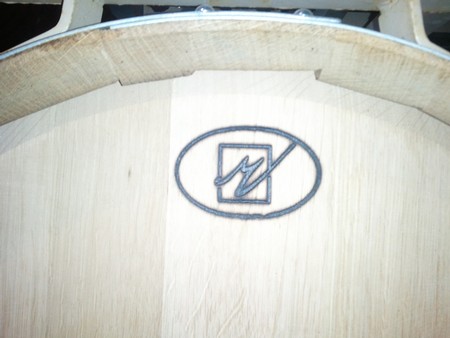
Powerful is the key word here. From 2007-2009 these barrels were only allowed to interact with Syrah, the power king of West Side Paso Robles. The method used for toasting these barrels produced wonderful flavors that softness to powerful wines like no other barrel I have ever used. As you can see here, the "House Toast", basically the toast the cooper feels is the best expression of their barrel, is made with Syrah in mind.

A house with the word Syrah is a foolproof way to tell the sleep deprived english speaking wine maker what to do with this barrel. Last year, after talking with the cooper and requesting a special lower temperature, longer timed toasting regiment, these barrels moved into Cabernet, Merlot and Petit Verdot. And after tasting through the barrels with him this past week, we were both very pleased with the outcome. This year he even had a new brazier designed that will allow an even milder yet deeper toast to the barrel.
This has led me to expectation of expanding the Meryrieux usage out to other varietals. Cab Franc, Pinot Noir (Meyrieux is located in Villers-La-Faye France after all), maybe even get crazy and put some Marsanne in one. We'll see. But one can not underestimate the importance of tailoring your barrel program to your wine making. And remember to thank the word's hard working artisan barrel makers the next time you taste perfect aging and oak integration in your glass.
Last night I hosted a Cabernet Franc tasting for the San Luis Obispo chapter of the American Wine Society. A nice little event that allowed me the pleasure of standing in front of the group and waxing poetic on what ever came to mind.
Whenever I am involved in a tasting that is going to be varietal based, I like to find an example that is "typical" of the varietal. Well, what's supposed to mean? Basically, when people stopped just drinking wine and decided they needed to write about it as well, where was that varietal grown and produced most commonly. Then general description of the varietal will be based on how it expresses itself from that region. Be it Pinot Noir from Burgundy or Viognier from the Rhone. In this case, I walked into our local wine shop, 15˚C, and asked for a Loire Valley red in the $15-$20 range. They supplied me with exactly what I was looking for, a 2009 from Bourgeil. It had the light body, high acid, clean drying tannins and herbaceous flavors that one would expect from a Cab Franc. The interesting part was that all 9 wines we would go on to blind taste were examples from the California Central Coast, and they would only have a passing resemblance to the Bourgueil.
It is quite vogue these days for people to talk about terroir and its importance to wine. There is no doubting that the place where the wine is produced has a massive impact on the final product. And tasting these 10 wines, I began to believe that terroir perhaps has the most important impact. Is Cab Franc known for high acid, light body, herbal aromas and bright red fruit character because of DNA, or because that is how it expresses itself in the Loire? The California wines were all of darker color, heavier aroma and more filling body. These were no California Cab Sauv fruit pies have you. The color had more reds than purples (even young), and there was still herbal flowery aromas, strong acid back bones, and firm tannins on the better examples. What really impressed me was the sensation that the better California wines achieved balance.
I'm now convinced that veteran wine critics haze the rookies by telling them their first big assignment is to go taste all the Loires. Much respect to anyone who's mouth is still functioning after tasting about 10 of this acid machines. When tasting the Bourgueil, the acid and drying tannins really stood out. They were much stronger features than the aroma, the mid-palate fruit or the finish. This to me is the basic concept of out of balance, where one feature of the wine really sticks out and carries the whole tasting experience. Think of a Chardonnay where all you can taste is oak. The wines I most appreciated during the blind tasting had a full rich nose, a wonderful bright acid fore-palate that moved into red fruits and clean firm tannins. The full nose prepared you for the the brightness of the acid, which was then balanced by the fruit and tannins, thus creating a wine with a harmonious drinking experience.
I would say that these California wines were a perfect example of what Cab Franc tastes like. Sure, some critics would balk at this. But here in Paso Robles, it is not only impossible, but pointless to produce a Bourgueil or Chinon style Cab Franc. The soil, the weather, the philosophy, and goals of the vineyard are drastically different. Thus the wines have to be different as well. To attempt copying a style not your own is pure folly. Is one wine a truer expression of Cab Franc? A silly question, for all we can do is present the wine as it expresses itself from where it was grown.
The most commonly asked question of our tasting room staff or to me while I am at events is, "What's the deal with the name Calcareous?" Well, maybe not exactly phrased like that, but you get the picture. The quick answer is that we have Calcareous soils here which means they are limestone-based. But the point of this blog is to be able to dig a bit deeper into these questions.
Many of the world's great wine growing regions are located above limestone deposits. Famed regions of France such as Châteauneuf-du-Pâpe, Saint Emilion, Alsace, and Burgundy all share the quality of having limestone soils. The reason limestone seems to be abundant in these great wine regions has been the subject of much debate and thorough research. The easy answer that the chalk imparts unique flavors or minerality to wine has been mostly rejected. There is however hard science proving that high pH, calcium rich soils do have a unique impact upon Vitis vinifera. For the sake of keeping this post somewhat managable, I won't go into all of that here. But if you are the inquiring type that enjoys bringing a bit of wine science to the dinner table or your next tasting, here are some resources. This primer by Valerie Saxton printed in the Wine Business Monthly is a great article for the scientifically inclined. Our neighbor and king of Paso Robles wine bloggers Jason Hass at Tablas Creek, took that info and summarized how it plays out here in Paso Robles.
So, with all that being said, if we dare call ourselves Calcareous, we better produce the limestone to back it up. So my assistant winemaker, two dogs and I went out into the vineyard on a hunt for this magical stone. One thing you'll notice walking around our vineyard, or even while driving the windy roads of West Paso, there are quite a few white chalky looking rocks laying around. My first inclination as a winemaker and lazy geologist was to point out to visitors, "Hark, behold the wonder of limestone!"
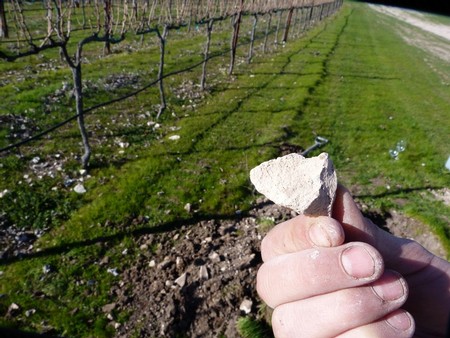
Well, sadly, one day a few years ago, an actual geologist was in one of my tour groups. There was a bit of snickering when I picked up my "limestone" and passed it around. Oh the sad comedy of the "know-it-all" winemaker getting called out by the scientist! What I was passing off as limestone was actually shale. I wasn’t way off the mark as it was shale that had some calcite amongst the clay. That's nice, but I wanted outright pure limestone bedrock here to make other vineyards jealous. We're Calcareous for pete's sake! My new scientist buddy told me if I had pure limestone, you would be able drop it in a strong acid and--boom--Carbon Dioxide will come bubbling forth. Sure, vinegar or even our Chardonnay has enough acid to make some slow bubbles, but that's not impressive enough. So, grabbing some Hydrochloric Acid from the wine lab, we put our rocks to the test. If you place that chunk of shale into the glass, pretty boring.
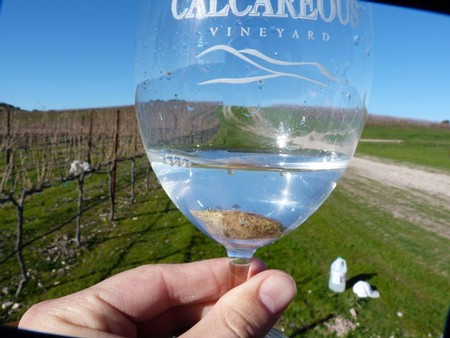
Nothing there to impress a viticulture geek, let alone any ladies on the tour. So we needed to find some of the good stuff. Que the shovels and the digging. Removing a couple feet of dark rich top soil and more chunks of shale had me feeling like Geraldo opening Al Capone's vault. But if you need to dig through a couple of meters of stone and clay at Chateau de Beaucastel to reach limestone, we had to keep going. Then, just a couple inches more and a new texture appeared. A soft, crumbly grayish rock-was this what we were seeking?

There's one fun way to find out, drop it in the glass of acid.
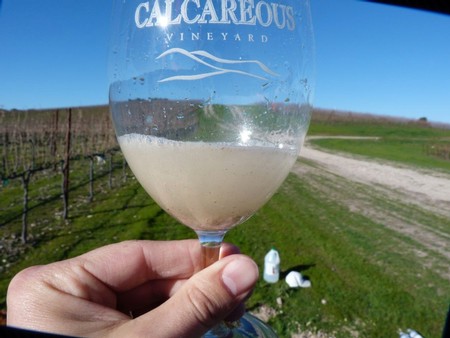
BINGO! And there was much rejoicing. So much excitement actually, we made the ill-fated decision to film me putting rocks into a glass. And the Internets are now richer for it.
So yes, we have limestone, and yes we are abundantly Calcareous. Great, why should any of you care? I know I promised not to go into this for brevity’s sake, but we’ve come this far. If you're still here, you deserve something. From my own personal experience, I have a few reasons to believe having limestone bedrock only a few feet below the surface makes our vineyard incredible. The first thing I have noticed is that we rarely have to drop fruit here. The vines are extremely non-vigorous in either vegetal growth or fruit set. We naturally only produce about 2 tons/acre of fruit. We had a bumper crop this year which netted 38 tons from our 18 acres of vines. What little fruit we do get is of astonishing intensity. The color, tannins, and flavors extracted from fruit here rivals any other fruit I have tasted.
Secondly, if you read any of the sources linked above, you will learn that high levels of acidity are maintained in fruit grown on limestone soils. We achieve wonderful levels of ripeness in our fruit yet maintain pH levels from 3.1-3.5 in all the varietals grown here. This gives us the great necessity of big, fully extracted, ripe wines to be truly palatable:balance. Sure, you can dump a bunch of factory made tartaric-acid in your overly ripe grapes to bring the pH down to where you want. But that can not, and will not replace the flavor of natural grape acids. Natural perfection can not be imitated. Thus from this world-class vineyard, where pure limestone is just a scratch below the surface, we are producing world-class wines.
-Jason